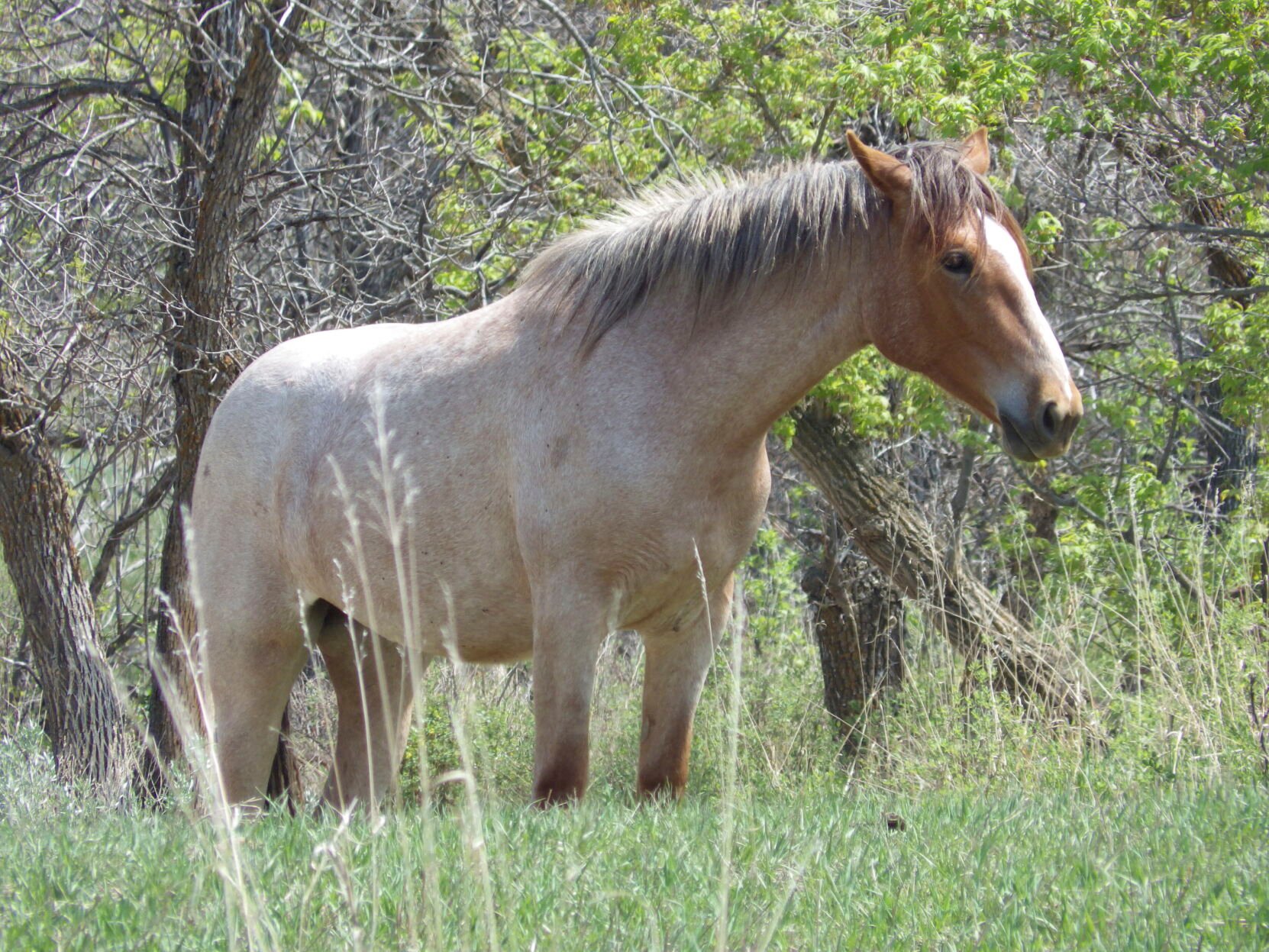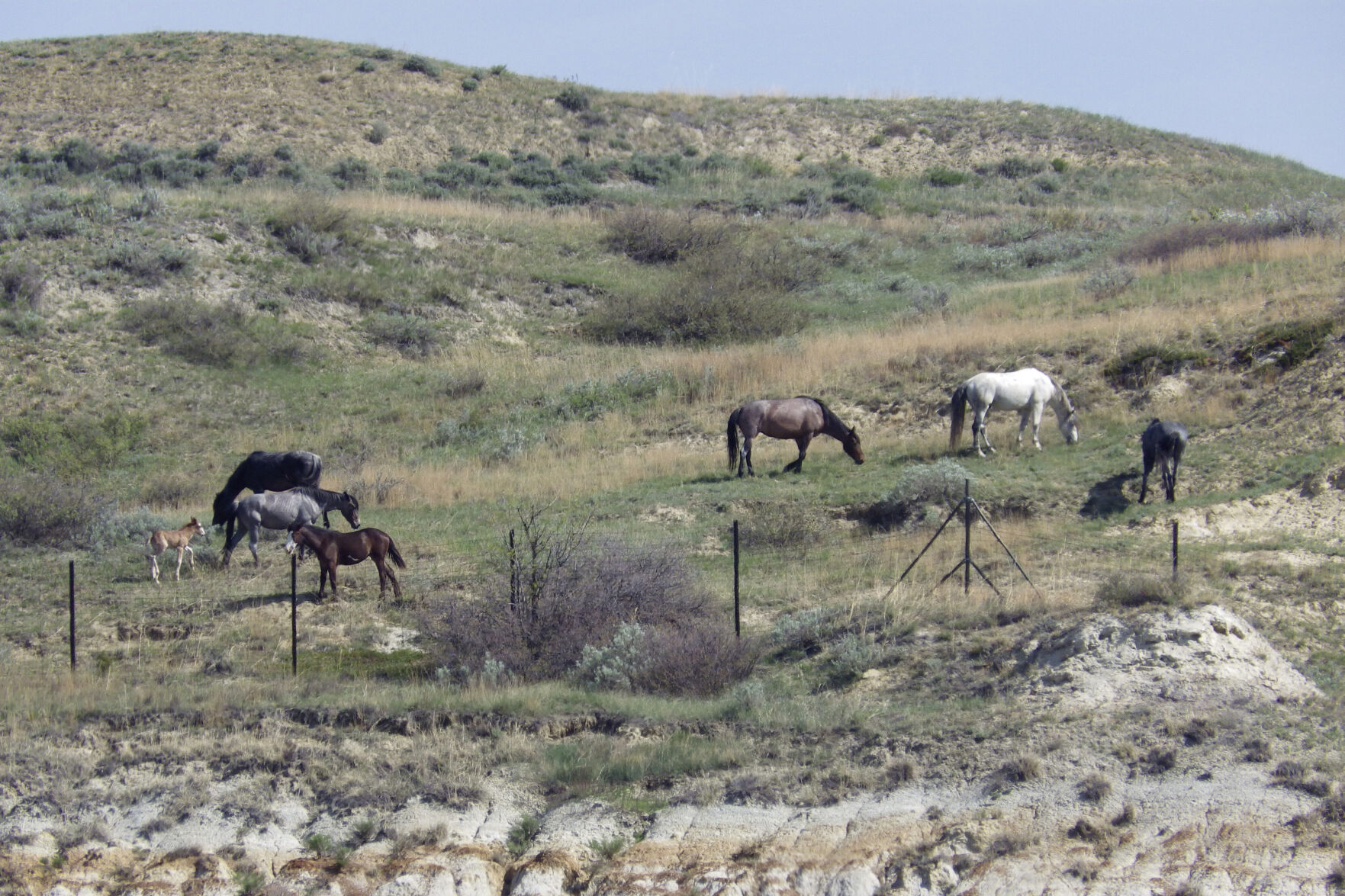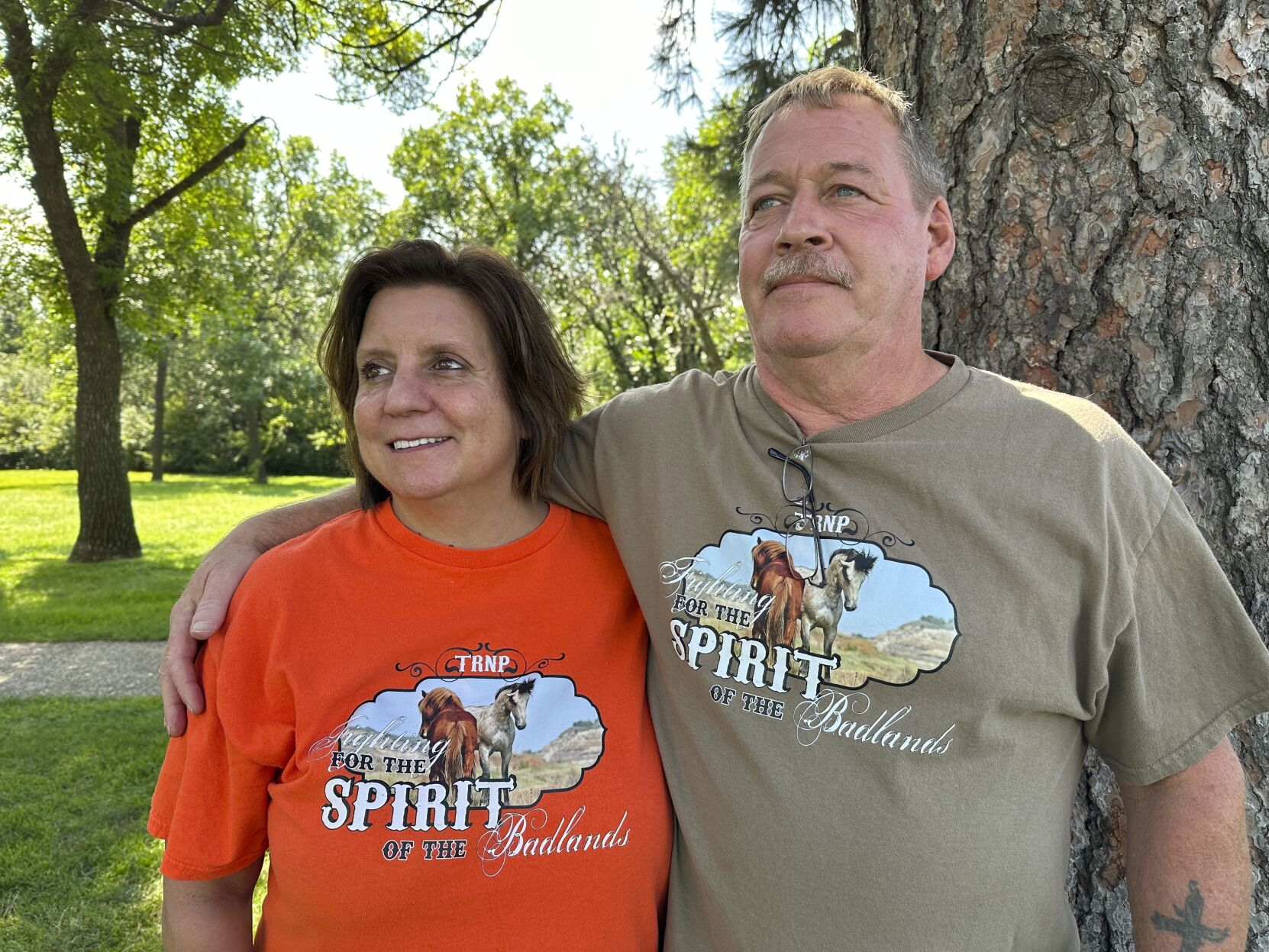BISMARCK, N.D. — The beloved wild horses that roam freely in North Dakota’s Theodore Roosevelt National Park could be removed under a National Park Service proposal that worries advocates who say the horses are a cultural link to the past.
Visitors who drive the scenic park road can often see bands of horses, a symbol of the West and sight that delights tourists. Advocates want to see the horses continue to roam the Badlands, and disagree with park officials who have branded the horses as “livestock.”
The Park Service is revising its livestock plans and writing an environmental assessment to examine the impacts of taking no new action — or to remove the horses altogether.

Jack Dura, Associated Press
A wild horse stands May 20 near Peaceful Valley Ranch in Theodore Roosevelt National Park near Medora, N.D. About 200 horses roam the park's South Unit. The National Park Service has proposed removing the horses popular with park visitors.
Removal would entail capturing horses and giving some of them first to tribes, and later auctioning the animals or giving them to other entities. Another approach would include techniques to prevent future reproduction and would allow those horses to live out the rest of their lives in the park.
The horses have allies in government leaders and advocacy groups. One advocate says the horses’ popularity won’t stop park officials from removing them from the landscape of North Dakota’s top tourist attraction.
“At the end of the day, that’s our national park paid for by our tax dollars, and those are our horses. We have a right to say what happens in our park and to the animals that live there,” Chasing Horses Wild Horse Advocates President Chris Kman said.

Jack Dura, Associated Press
Wild horses graze on a hillside May 20 near the boundary fence of Theodore Roosevelt National Park near Medora, N.D.
Last year, Park Superintendent Angie Richman told The Bismarck Tribune that the park has no law or requirement for the horses to be in the park. Regardless of what decision is ultimately made, the park will have to reduce its roughly 200 horses to 35-60 animals under a 1978 environmental assessment’s population objective, she previously said.
Kman said she would like the park “to use science” to “properly manage the horses,” including a minimum of 150-200 reproductive horses for genetic viability. Impacts of the park’s use of a contraceptive on mares are unclear, she added.
Ousting the horse population “would have a detrimental impact on the park as an ecosystem,” Kman said. The horses are a historical fixture, while the park reintroduced bison and elk, she said.
A couple bands of wild horses were accidentally fenced into the park after it was established in 1947, said Castle McLaughlin, who in the 1980s researched the history and origins of the horses while working as a graduate student for the Park Service in North Dakota.
Park officials in the early years sought to eradicate the horses, shooting them on sight and hiring local cowboys to round them up and remove them, she said. The park even sold horses to a local zoo at one point to be food for large cats.
Around 1970, a new superintendent discovered Roosevelt had written about the presence of wild horses in the Badlands during his time there. Park officials decided to retain the horses as a historic demonstration herd to interpret the open-range ranching era. “However, the Park Service still wasn’t thrilled about them,” McLaughlin said.
“Basically they’re like cultural artifacts almost because they reflect several generations of western North Dakota ranchers and Native people. They were part of those communities,” and might have ties to Hunkpapa Lakota leader Sitting Bull, she said.
In the 1880s, Theodore Roosevelt hunted and ranched as a young man in the Badlands of what is now western North Dakota. The Western tourist town of Medora is at the gates of the national park that bears his name.
Roosevelt looms large in North Dakota, where a presidential library in his honor is under construction near the park — a legislative push in 2019 that was championed by Republican Gov. Doug Burgum.
Burgum has offered for the state to collaborate with the Park Service to manage the horses. Earlier this year, North Dakota’s Republican-controlled Legislature passed a resolution in support of preserving the horses.
Republican U.S. Sen. John Hoeven of North Dakota has included legislation in the U.S. Interior Department’s appropriations bill that he told the AP “would direct them to keep horses in the park in line with what was there at the time that Teddy Roosevelt was out in Medora.”
The senator said he expects the environmental review to be completed soon, which will provide an opportunity for public comment. Richman told the AP the park plans to release the assessment this summer. A timeline for a final decision is unclear.
The environmental review will look at the impact of each of the three proposals in a variety of areas, said Maureen McGee-Ballinger, the park’s deputy superintendent.

Jack Dura, Associated Press
Chris, left, and Gary Kman of Chasing Horses Wild Horse Advocates are fighting the proposal to remove the horses. Ousting the horse population “would have a detrimental impact on the park as an ecosystem,” Chris Kman said.
There were thousands of responses during the previous public comment period on the park’s proposals — the vast majority of which opposed “complete livestock removal.”
Kman’s group has been active in gathering support for the horses, including drafting government resolutions and contacting congressional offices, tribal leaders, similar advocacy groups and “pretty much anyone that would listen to me,” she said.
The park’s North Unit, about 70 miles from Medora, has about nine longhorn cattle. The proposals would affect the longhorns, too, though the horses are the greater concern. Hoeven said his legislation doesn’t address the longhorns. The cattle are managed under a 1970 plan.
-
Wild horses that roam Theodore Roosevelt National Park may be removed. Many oppose the plan
Melissa Hemken
Located on the Oldham family's 900-acre Double D Ranch, the sanctuary is one of three BLM eco-sanctuaries that has historically been open for public tours (children under 12 are free) and the only one on a Native American reservation. The family cares for approximately 130 wild horses or mustangs in Wind River country east of Yellowstone National Park. Stop in to the free Visitor Center for an interpretative display on the importance of the horse in the culture and traditions of Native Americans, as well as the history of wild horses in North America. Ask about the mustang adoption program. Contact: https://www.windriverwildhorses.com; https://www.travelwyoming.com
Melissa Hemken
Located on the Oldham family's 900-acre Double D Ranch, the sanctuary is one of three BLM eco-sanctuaries that has historically been open for public tours (children under 12 are free) and the only one on a Native American reservation. The family cares for approximately 130 wild horses or mustangs in Wind River country east of Yellowstone National Park. Stop in to the free Visitor Center for an interpretative display on the importance of the horse in the culture and traditions of Native Americans, as well as the history of wild horses in North America. Ask about the mustang adoption program. Contact: https://www.windriverwildhorses.com; https://www.travelwyoming.com
-
Wild horses that roam Theodore Roosevelt National Park may be removed. Many oppose the plan
The Virginia Range, an area of about 30 square miles, in Northern Nevada had a major moment in the sun when it served as home to television's Cartwright family for the 1960s Western series "Bonanza." Today it is home to a free-roaming herd, among the first to be protected through legislation pushed through by animal activist Velma Johnston, known as "Wild Horse Annie." Consider taking a hike into the area, and be on the lookout for mustangs gathered around watering holes. You might also catch a glimpse of the herd from Route 341. Contact: www.TravelNevada.com
The Virginia Range, an area of about 30 square miles, in Northern Nevada had a major moment in the sun when it served as home to television's Cartwright family for the 1960s Western series "Bonanza." Today it is home to a free-roaming herd, among the first to be protected through legislation pushed through by animal activist Velma Johnston, known as "Wild Horse Annie." Consider taking a hike into the area, and be on the lookout for mustangs gathered around watering holes. You might also catch a glimpse of the herd from Route 341. Contact: www.TravelNevada.com
-
-
Wild horses that roam Theodore Roosevelt National Park may be removed. Many oppose the plan
Learn about the evolution, habitat, social interaction and historical significance of this mustang herd during a tour of the extraordinary landscape that is their home. Many believe the magnificent creatures are descendants of Spanish horses brought to the area by Native American tribes, including the Crow. Tours for single groups already traveling together will be available this summer. Sightings might include bear, Big Horn sheep and other wildlife as you traverse land that straddles the Montana and Wyoming border.
Contact: www.pryormustangs.org; www.visitmt.com; www.travelwyoming.com.
Learn about the evolution, habitat, social interaction and historical significance of this mustang herd during a tour of the extraordinary landscape that is their home. Many believe the magnificent creatures are descendants of Spanish horses brought to the area by Native American tribes, including the Crow. Tours for single groups already traveling together will be available this summer. Sightings might include bear, Big Horn sheep and other wildlife as you traverse land that straddles the Montana and Wyoming border.
Contact: www.pryormustangs.org; www.visitmt.com; www.travelwyoming.com.
-
Wild horses that roam Theodore Roosevelt National Park may be removed. Many oppose the plan
With an authentic and scenic setting as backdrop, you and your family can enjoy beautiful places and learn horsemanship from experienced hands who will tailor the instruction to your skill and interest level. Opt to ride in open meadows, on mountain trails or in the desert Southwest. Will your family members choose to participate in a real cattle drive? Are you up for a horse pack trip into the backcountry? Will your youngsters be eager to learn the skills required for team penning and other arena games? Or will you be happy to relax during daily trail rides. The options are yours at working dude ranches and guest ranches across the country.
Contact: www.duderanches.com; www.HomeRanch.com.
With an authentic and scenic setting as backdrop, you and your family can enjoy beautiful places and learn horsemanship from experienced hands who will tailor the instruction to your skill and interest level. Opt to ride in open meadows, on mountain trails or in the desert Southwest. Will your family members choose to participate in a real cattle drive? Are you up for a horse pack trip into the backcountry? Will your youngsters be eager to learn the skills required for team penning and other arena games? Or will you be happy to relax during daily trail rides. The options are yours at working dude ranches and guest ranches across the country.
Contact: www.duderanches.com; www.HomeRanch.com.
-
-
Wild horses that roam Theodore Roosevelt National Park may be removed. Many oppose the plan
This magnificent stretch of beach is perhaps most well-known for the wild Chincoteague ponies that make their annual swim across the Assateague Channel. Locals often suppose the horses are survivors of a shipwreck off the Virginia coast, though it's not been confirmed. The Seashore, a part of the Chincoteague National Wildlife Refuge, is also home to more than 300 species of birds as well as miles of trails for biking and hiking. Make time for beachcombing, kayaking, swimming and keeping eyes out for eagles overhead and dolphins in the water.
Contact: www.nps.gov/asis/index.htm
___
(Lynn O'Rourke Hayes (www.LOHayes.com) is an author, family travel expert and enthusiastic explorer. Gather more travel intel on Twitter @lohayes, Facebook, or via FamilyTravel.com)
This magnificent stretch of beach is perhaps most well-known for the wild Chincoteague ponies that make their annual swim across the Assateague Channel. Locals often suppose the horses are survivors of a shipwreck off the Virginia coast, though it's not been confirmed. The Seashore, a part of the Chincoteague National Wildlife Refuge, is also home to more than 300 species of birds as well as miles of trails for biking and hiking. Make time for beachcombing, kayaking, swimming and keeping eyes out for eagles overhead and dolphins in the water.
Contact: www.nps.gov/asis/index.htm
___
(Lynn O'Rourke Hayes (www.LOHayes.com) is an author, family travel expert and enthusiastic explorer. Gather more travel intel on Twitter @lohayes, Facebook, or via FamilyTravel.com)



